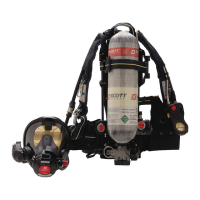19
WARNING
THE RESPIRATOR USER MUST IMMEDI-
ATELY LEAVE THE AREA REQUIRING
RESPIRATORY PROTECTION WHEN AN END
OF SERVICE INDICATOR ALARM ACTU-
ATES. ACTUATION OF ANY END OF
SERVICE INDICATOR ALARM WARNS THE
USER THAT APPROXIMATELY 25% OF FULL
PRESSURE REMAINS IN THE AIR SUPPLY
CYLINDER (THAT IS, APPROXIMATELY 3/4
OF THE TOTAL AIR SUPPLY HAS BEEN
USED) OR THAT THERE IS A MALFUNCTION
IN THE RESPIRATOR. A DELAY IN LEAVING
THE AREA AFTER ALARM ACTUATION MAY
RESULT IN SERIOUS INJURY OR DEATH.
WARNING
ALWAYS START WITH A FULL AIR SUPPLY
CYLINDER. PARTIALLY FILLED CYLIN-
DERS SHOULD ONLY BE USED IN
EMERGENCY CONDITIONS IF FULL CYLIN-
DERS ARE NOT AVAILABLE. BEFORE
ENTERING A POTENTIALLY HAZARDOUS
ATMOSPHERE, THE USER MUST DETER-
MINE THAT THE CYLINDER CONTAINS
SUFFICIENT AIR TO ALLOW TIME FOR
COMPLETION OF THE TASK INVOLVED
AND RETURN TO A SAFE ATMOSPHERE
WITH AN ADEQUATE MARGIN FOR
SAFETY. ENTERING A HAZARDOUS ATMO-
SPHERE WITH INSUFFICIENT AIR OR
AFTER THE END OF SERVICE TIME INDI-
CATOR HAS ACTUATED MAY RESULT IN
SERIOUS INJURY OR DEATH.
12. Proceed with use of respirator in accordance with your respira-
tory protection program.
EVERY ENTRY INTO A CONTAMINATED OR UNKNOWN ATMO-
SPHERE SHOULD BE PLANNED TO ENSURE THAT THERE IS
SUFFICIENT AIR SUPPLY TO ENTER, CARRY OUT THE TASKS
REQUIRED AND RETURN TO A SAFE BREATHING AREA. THE
USER SHOULD CHECK THE REMOTE READING PRESSURE
GAUGE ON THE SHOULDER STRAP PERIODICALLY TO DETER-
MINE THE RATE OF AIR CONSUMPTION. IN ANY EVENT, THE
USER MUST BE CERTAIN TO ALLOW SUFFICIENT AIR FOR
EGRESS FROM THE CONTAMINATED AREA. IF ENTRY IS AT-
TEMPTED AFTER THE AIR HAS BEEN PARTIALLY CONSUMED
(CYLINDER LESS THAN FULL), THE USER MUST BE CERTAIN
THAT THE REMAINING AIR WILL BE SUFFICIENT FOR SAFETY.
If either end of service indicator alarm, the VIBRALERT alarm or the
HEADS-UP DISPLAY actuates either individually or together, leave
the area requiring respiratory protection immediately. When in a safe
area where you are certain that respiratory protection is not required,
terminate the use of the respirator, (see TERMINATION OF USE sec-
tion of this instruction) and determine the cause of the alarm. Where
the cause of the alarm activation is determined to be a depleted air
supply cylinder, replace the cylinder in accordance with the CYLIN-
DER REPLACEMENT PROCEDURE section of this instruction. Do
not resume the use of a respirator where any end of service indica-
tor alarm has actuated for an unknown reason. Remove such a res-
pirator from service and tag it for repair by authorized personnel.
LOW BATTERY
As the batteries begin to approach the end of their useful life, the low battery
condition will be signified by the following:
1. The backframe module will begin to sound a chirp approximately
every two seconds.
2. The round LOW BATTERY indicator at the far right of the HEADS-
UP display will light for twenty (20) seconds and then begin to flash
slowly at once a second.
3. If the respirator is equipped with a PASS DEVICE distress alarm,
the green lights on the control module and backframe will go out.
While in low battery condition, the HEADS-UP display and the PASS DE-
VICE distress alarm will continue to operate for a period of time greater then
the longest duration cylinder available for the respirator. However, the batter-
ies must be replaced before the respirator is used again. See BATTERY
REPLACEMENT section of these instructions.
WARNING
FAILURE TO REPLACE THE BATTERIES AND/
OR CONTINUING WITH MULTIPLE USES OF
THE RESPIRATOR AFTER THE LOW BAT-
TERY CONDITION HAS BEEN INDICATED BY
THE PASS DEVICE DISTRESS ALARM MAY
RESULT IN FAILURE OF THE PASS DEVICE
DISTRESS ALARM DURING USE AND POS-
SIBLE INJURY OR DEATH OF THE USER.

